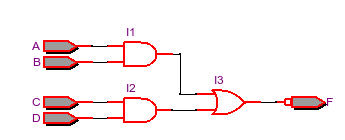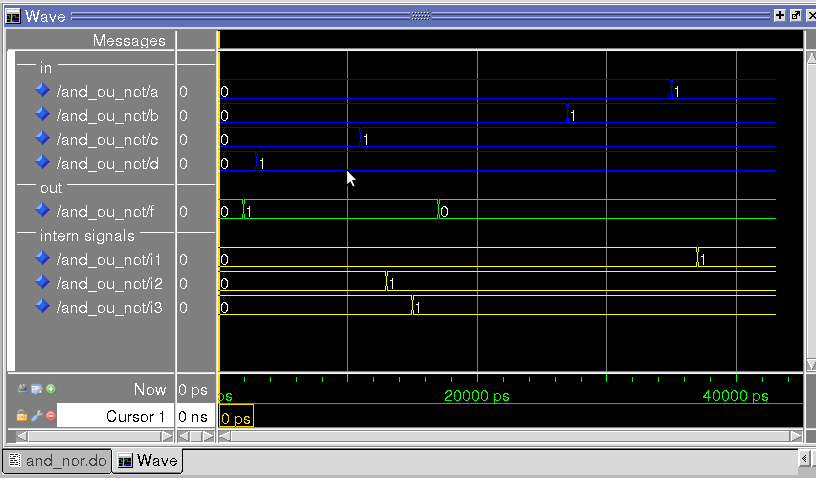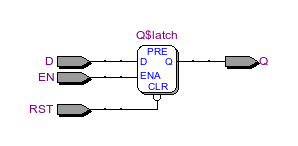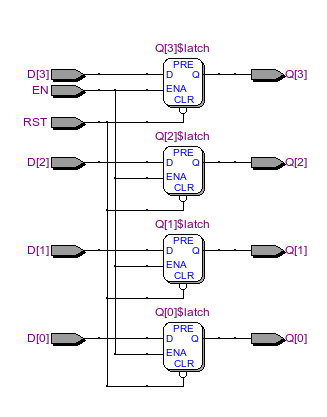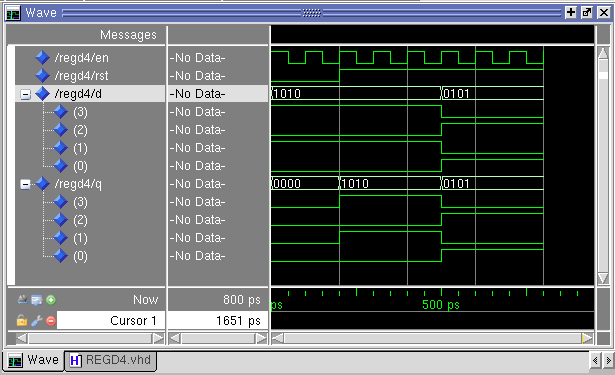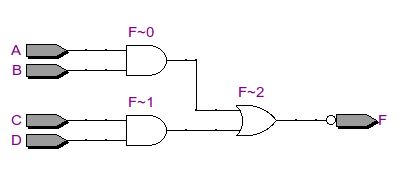Mudanças entre as edições de "Códigos VHDL para uso nas Aulas 2011-1"
| (31 revisões intermediárias por 2 usuários não estão sendo mostradas) | |||
| Linha 1: | Linha 1: | ||
== Descrição do hardware de uma porta E == | == Descrição do hardware de uma porta E == | ||
| − | <syntaxhighlight lang= | + | <syntaxhighlight lang=vhdl> |
entity PortaE is | entity PortaE is | ||
port | port | ||
| Linha 17: | Linha 17: | ||
end architecture v1; | end architecture v1; | ||
</syntaxhighlight> | </syntaxhighlight> | ||
| + | |||
| + | |||
| + | == Descrição do hardware de um multiplexador de 4 para 1== | ||
| + | |||
| + | <syntaxhighlight lang=vhdl> | ||
| + | entity mux_novo is | ||
| + | port | ||
| + | ( | ||
| + | -- Input ports | ||
| + | X: in bit_vector (3 downto 0); | ||
| + | S : in bit_vector (1 downto 0); | ||
| + | -- Output ports | ||
| + | Y : out bit | ||
| + | ); | ||
| + | end entity mux_novo; | ||
| + | |||
| + | -- Implementação com lógica pura | ||
| + | architecture Logica_pura of mux_novo is | ||
| + | |||
| + | begin | ||
| + | Y <= (X(0) and (not S(1)) and (not S(0))) or | ||
| + | (X(1) and (not S(1)) and (S(0))) or | ||
| + | (X(2) and (S(1)) and (not S(0))) or | ||
| + | (X(3) and (S(1)) and (S(0))); | ||
| + | end architecture Logica_pura; | ||
| + | |||
| + | -- Implementação com WHEN ELSE | ||
| + | architecture v_WHEN of mux_novo is | ||
| + | |||
| + | begin | ||
| + | Y <= X(0) when S = "00" else | ||
| + | X(1) when S = "01" else | ||
| + | X(2) when S = "10" else | ||
| + | X(3); | ||
| + | end architecture v_WHEN; | ||
| + | |||
| + | -- Implementação com WITH SELECT | ||
| + | architecture v_WITH_SELECT of mux_novo is | ||
| + | |||
| + | begin | ||
| + | with S select | ||
| + | Y <= X(0) when "00", -- note o uso da , | ||
| + | X(1) when "01", | ||
| + | X(2) when "10", | ||
| + | X(3) when others; -- note o uso de others, para todos os demais valores. | ||
| + | -- Não pode ser substituido por "11" mesmo que o signal seja bit_vector. | ||
| + | end architecture v_WITH_SELECT; | ||
| + | |||
| + | -- Implementação com IF ELSE | ||
| + | architecture v_IF_ELSE of mux_novo is | ||
| + | |||
| + | begin | ||
| + | |||
| + | |||
| + | end architecture v_IF_ELSET; | ||
| + | </syntaxhighlight> | ||
| + | |||
| + | <code> | ||
| + | vcom -93 -work work {/home/moecke/SST-2011-1/mux_41/mux_41.vhd} | ||
| + | vsim work.mux_41 | ||
| + | add wave \ | ||
| + | {sim:/mux_41/x } \ | ||
| + | {sim:/mux_41/s } \ | ||
| + | {sim:/mux_41/y } | ||
| + | |||
| + | # testando entrada 0 | ||
| + | force -freeze sim:/mux_41/s 00 0 | ||
| + | force -freeze sim:/mux_41/x 0001 0 | ||
| + | run | ||
| + | force -freeze sim:/mux_41/x 1110 0 | ||
| + | run | ||
| + | # testando entrada 1 | ||
| + | force -freeze sim:/mux_41/s 01 0 | ||
| + | force -freeze sim:/mux_41/x 0010 0 | ||
| + | run | ||
| + | force -freeze sim:/mux_41/x 1101 0 | ||
| + | run | ||
| + | # testando entrada 2 | ||
| + | force -freeze sim:/mux_41/s 10 0 | ||
| + | force -freeze sim:/mux_41/x 0100 0 | ||
| + | run | ||
| + | force -freeze sim:/mux_41/x 1011 0 | ||
| + | run | ||
| + | # testando entrada 3 | ||
| + | force -freeze sim:/mux_41/s 11 0 | ||
| + | force -freeze sim:/mux_41/x 1000 0 | ||
| + | run | ||
| + | force -freeze sim:/mux_41/x 0111 0 | ||
| + | run | ||
| + | </syntaxhighlight> | ||
| + | |||
| + | == Circuito AND_NOR usando códigos sequenciais== | ||
| + | O circuito descrito abaixo somente executa o processo AND_GATES, quando uma das entradas (A, B, C ou D) é alterada. O mesmo ocorre em relação ao processo OR_GATE, que é executado quando uma das entradas I1 ou I2 é alterada. Finalmente o processo NOT_GATE é executado quando a entrada I3 é alterada. | ||
| + | |||
| + | Note que na primeira execução, todos os processos são executados uma vez, de modo a estabelecer valores iniciais válidos. Ou seja se todas entradas A, B, C, D estiverem em "0" => I1, I2, I3 = "0", => F = "1". Este valor é assumido após 2 ns no simulador. | ||
| + | |||
| + | <syntaxhighlight lang=vhdl> | ||
| + | entity and_or_not is | ||
| + | port | ||
| + | ( | ||
| + | A,B,C,D : in bit; | ||
| + | F : out bit | ||
| + | ); | ||
| + | end and_or_not; | ||
| + | |||
| + | |||
| + | architecture v1 of and_or_not is | ||
| + | |||
| + | signal I1,I2,I3 : bit; | ||
| + | |||
| + | begin | ||
| + | AND_GATES: | ||
| + | process(A, B, C, D) is | ||
| + | begin | ||
| + | I1 <= A and B after 2ns; | ||
| + | I2 <= C and D after 2ns; | ||
| + | end process; | ||
| + | |||
| + | OR_GATE: | ||
| + | process(I1, I2) is | ||
| + | begin | ||
| + | I3 <= I1 or I2 after 2ns; | ||
| + | end process; | ||
| + | |||
| + | NOT_GATE: | ||
| + | process(I3) is | ||
| + | begin | ||
| + | F <= not I3 after 2ns; | ||
| + | end process; | ||
| + | |||
| + | end v1; | ||
| + | |||
| + | </syntaxhighlight> | ||
| + | |||
| + | [[Imagem:and_nor.png|400px]] | ||
| + | |||
| + | Arquivo para teste em MODELSIM-ALTERA | ||
| + | <code> | ||
| + | vcom -93 -work work {/home/moecke/SST-2011-1/and_ou_not/and_ou_not.vhd} | ||
| + | vsim work.and_ou_not | ||
| + | |||
| + | add wave -divider {in} | ||
| + | add wave -color blue -format literal \ | ||
| + | {sim:/and_ou_not/a } \ | ||
| + | {sim:/and_ou_not/b } \ | ||
| + | {sim:/and_ou_not/c } \ | ||
| + | {sim:/and_ou_not/d } | ||
| + | |||
| + | add wave -divider {out} | ||
| + | add wave -color green -format literal\ | ||
| + | {sim:/and_ou_not/f } | ||
| + | |||
| + | add wave -divider {intern signals} | ||
| + | add wave -color yellow -format literal\ | ||
| + | {sim:/and_ou_not/i1 } \ | ||
| + | {sim:/and_ou_not/i2 } \ | ||
| + | {sim:/and_ou_not/i3 } | ||
| + | |||
| + | # Aguarda estabilizaçao inicial | ||
| + | run 3 ns | ||
| + | force -freeze sim:/and_ou_not/d 1 0 | ||
| + | run 8 ns | ||
| + | force -freeze sim:/and_ou_not/c 1 0 | ||
| + | run 8 ns | ||
| + | force -freeze sim:/and_ou_not/b 0 0 | ||
| + | run 8 ns | ||
| + | force -freeze sim:/and_ou_not/b 1 0 | ||
| + | run 8 ns | ||
| + | force -freeze sim:/and_ou_not/a 1 0 | ||
| + | run 8 ns | ||
| + | wave zoomfull | ||
| + | </syntaxhighlight> | ||
| + | Resultado do teste acima. | ||
| + | |||
| + | [[Imagem:and_nor_simul.png |600 px]] | ||
== Descrição do hardware de um Latch tipo D == | == Descrição do hardware de um Latch tipo D == | ||
O circuito descrito é ativo a entrada alto a entrada '''EN''' e ativo ao reset baixo '''RST''' | O circuito descrito é ativo a entrada alto a entrada '''EN''' e ativo ao reset baixo '''RST''' | ||
| − | <syntaxhighlight lang= | + | <syntaxhighlight lang=vhdl> |
library IEEE; | library IEEE; | ||
use IEEE.std_logic_1164.all; | use IEEE.std_logic_1164.all; | ||
| Linha 49: | Linha 224: | ||
end architecture v1; | end architecture v1; | ||
</syntaxhighlight> | </syntaxhighlight> | ||
| + | |||
| + | [[Imagem:LATCHD.png|400px]] | ||
| + | |||
| + | == Descrição do hardware de um registrador com 4 Latch tipo D == | ||
| + | O circuito descrito é ativo a entrada alto a entrada '''EN''' e ativo ao reset baixo '''RST''' | ||
| + | |||
| + | <syntaxhighlight lang=vhdl> | ||
| + | library IEEE; | ||
| + | use IEEE.std_logic_1164.all; | ||
| + | |||
| + | entity REGD4 is | ||
| + | port( | ||
| + | EN, RST: in std_logic; | ||
| + | D: in std_logic_vector (3 downto 0); | ||
| + | Q: out std_logic_vector (3 downto 0) | ||
| + | ); | ||
| + | end entity REG; | ||
| + | |||
| + | architecture v1 of REGD4 is | ||
| + | |||
| + | begin | ||
| + | |||
| + | process (D,EN,RST) | ||
| + | begin | ||
| + | if (RST = '0') then | ||
| + | Q <= "0000"; -- reset ocorre quando RST=0 | ||
| + | elsif (EN = '1') then | ||
| + | Q <= D; -- O valor de D passa para Q quando EN=1 | ||
| + | end if | ||
| + | end process; | ||
| + | |||
| + | end architecture v1; | ||
| + | |||
| + | </syntaxhighlight> | ||
| + | [[Imagem:REGD4-RTL.png]] | ||
| + | [[Imagem:REG4_SIM.png]] | ||
| + | |||
| + | == Descrição do hardware de um registrador com N Latch tipo D == | ||
| + | O circuito descrito é ativo a entrada alto a entrada '''EN''' e ativo ao reset baixo '''RST''' | ||
| + | Note neste exemplo o poder do VHDL de parametrizar o tamanho do registrador através do ''generic'' | ||
| + | |||
| + | <syntaxhighlight lang=vhdl> | ||
| + | |||
| + | library IEEE; | ||
| + | use IEEE.std_logic_1164.all; | ||
| + | |||
| + | entity REGDN is | ||
| + | generic (N: integer := 4) | ||
| + | port(EN, RST: in std_logic; | ||
| + | D: in std_logic_vector (N-1 downto 0); | ||
| + | Q: out std_logic_vector (N-1 downto 0)); | ||
| + | end entity REGDN ; | ||
| + | |||
| + | architecture v2 of REGDN is | ||
| + | begin | ||
| + | process (D,EN,RST) | ||
| + | begin | ||
| + | if (RST = '0') then | ||
| + | Q <= (others => '0'); -- reset todos os bits Q quando RST=0 | ||
| + | elsif (EN = '1') then | ||
| + | Q <= D; -- passa todos os valores de D para as saídas Q correspondentes | ||
| + | end if; | ||
| + | end process; | ||
| + | end architecture v2; | ||
| + | |||
| + | </syntaxhighlight> | ||
| + | |||
| + | == Descrição do hardware de um Flip Flop tipo D == | ||
| + | O circuito descrito é ativo a entrada de clk sensível a borda de subida | ||
| + | |||
| + | <syntaxhighlight lang=vhdl> | ||
| + | --------------------------------------- | ||
| + | LIBRARY ieee; | ||
| + | USE ieee.std_logic_1164.all; | ||
| + | --------------------------------------- | ||
| + | ENTITY DFF IS | ||
| + | PORT | ||
| + | ( | ||
| + | d, clk, rst: IN STD_LOGIC; | ||
| + | q: OUT STD_LOGIC | ||
| + | ); | ||
| + | END DFF; | ||
| + | --------------------------------------- | ||
| + | ARCHITECTURE behavior OF DFF IS | ||
| + | |||
| + | BEGIN | ||
| + | PROCESS (rst, clk) | ||
| + | BEGIN | ||
| + | IF (rst='1') THEN | ||
| + | q <= '0'; | ||
| + | ELSIF (clk'EVENT AND clk='1') THEN | ||
| + | q <= d; | ||
| + | END IF; | ||
| + | |||
| + | END PROCESS; | ||
| + | END behavior; | ||
| + | --------------------------------------- | ||
| + | |||
| + | </syntaxhighlight> | ||
| + | |||
| + | <!-- | ||
| + | == Descrição do hardware de um Flip Flop tipo D == | ||
| + | O circuito descrito é ativo a entrada de clk sensível a borda de subida | ||
| + | |||
| + | <syntaxhighlight lang=vhdl> | ||
| + | |||
| + | entity FFD is | ||
| + | port ( | ||
| + | clk, D: in bit; | ||
| + | Q: out bit | ||
| + | ); | ||
| + | end entity FFD; | ||
| + | |||
| + | architecture v1 of FFDis | ||
| + | |||
| + | begin | ||
| + | |||
| + | process (clk) | ||
| + | begin | ||
| + | if (clk’event and clk=’1’) then -- este evento só ocorre na borda de subida do clk (rising edge) | ||
| + | Q <= D; | ||
| + | end if; | ||
| + | end process; | ||
| + | |||
| + | end architecture v1; | ||
| + | |||
| + | </syntaxhighlight> | ||
| + | |||
| + | --> | ||
| + | |||
| + | == Implementação de uma lógica combinacional And + Ou + Inversor (Direta) == | ||
| + | |||
| + | <syntaxhighlight lang=vhdl> | ||
| + | library ieee; | ||
| + | use ieee.std_logic_1164.all; | ||
| + | |||
| + | entity AOI is | ||
| + | port | ||
| + | ( | ||
| + | A,B, C, D : in std_logic; | ||
| + | F : out std_logic | ||
| + | ); | ||
| + | end AOI; | ||
| + | |||
| + | architecture v1 of AOI is | ||
| + | begin | ||
| + | F <= not((A and B) or (C and D)); | ||
| + | end v1; | ||
| + | |||
| + | </syntaxhighlight> | ||
| + | |||
| + | [[Imagem:AOIv1.png]] | ||
| + | |||
| + | <syntaxhighlight lang=vhdl> | ||
| + | architecture v2 of AOI is | ||
| + | signal I1, I2, I3 : std_logic; | ||
| + | begin | ||
| + | I1 <= A and B; | ||
| + | I2 <= C and D; | ||
| + | I3 <= I1 or I2; | ||
| + | F <= not I3; | ||
| + | end v2; | ||
| + | </syntaxhighlight> | ||
| + | |||
| + | ==Problema 2.1: Multiplexer == | ||
| + | Faça um multiplexador que selecione a entrada A para sel ='01', B para sel ='10', coloque '0...0' na saída para sel ='00'e mantenha a saída em alta impedância "Z...Z" quando sel='11'. | ||
| + | |||
| + | |||
| + | <syntaxhighlight lang=vhdl> | ||
| + | --------------------------------------- | ||
| + | LIBRARY ieee; | ||
| + | USE _________________________ ; | ||
| + | --------------------------------------- | ||
| + | ENTITY mux IS | ||
| + | PORT ( __ , __ : ___ STD_LOGIC_VECTOR (7 DOWNTO 0); | ||
| + | sel : IN ____________________________ ; | ||
| + | ___ : OUT STD_LOGIC_VECTOR (7 DOWNTO 0)); | ||
| + | END _____ ; | ||
| + | --------------------------------------- | ||
| + | ARCHITECTURE example OF _____ IS | ||
| + | BEGIN | ||
| + | PROCESS (a, b, ____ ) | ||
| + | BEGIN | ||
| + | IF (sel = "00") THEN | ||
| + | c <= "00000000"; | ||
| + | ELSIF (__________) THEN | ||
| + | c <= a; | ||
| + | _____ (sel = "10") THEN | ||
| + | c <= __; | ||
| + | ELSE | ||
| + | c <= (OTHERS => '__'); | ||
| + | END ___ ; | ||
| + | END _________ ; | ||
| + | END _________ ; | ||
| + | --------------------------------------- | ||
| + | |||
| + | </syntaxhighlight> | ||
| + | |||
| + | |||
| + | ==Problema 4.1: Decodificador Genérico - ativo baixo == | ||
| + | Faça um circuito que tenha duas entradas, sel (m bits) e ena (um bit), e uma saída x (n bits). Considere que n é potência binaria de dois, e m = log2 n. Se ena = '0', então todos os bits de x devem assumir o valor alto; caso contrário (ena = '1'), o bit correspondente ao valor indicado por sel deve ser '0' enquanto que os demais bits permanecem em '1'. Use o código abaixo como base para a generalização. | ||
| + | |||
| + | <syntaxhighlight lang=vhdl> | ||
| + | --------------------------------------------- | ||
| + | LIBRARY ieee; | ||
| + | USE ieee.std_logic_1164.all; | ||
| + | --------------------------------------------- | ||
| + | ENTITY decoder IS | ||
| + | PORT ( | ||
| + | ena : IN STD_LOGIC; | ||
| + | sel : IN STD_LOGIC_VECTOR (2 DOWNTO 0); | ||
| + | x : OUT STD_LOGIC_VECTOR (7 DOWNTO 0)); | ||
| + | END decoder; | ||
| + | --------------------------------------------- | ||
| + | ARCHITECTURE generic_decoder OF decoder IS | ||
| + | BEGIN | ||
| + | PROCESS (ena, sel) | ||
| + | VARIABLE temp1 : STD_LOGIC_VECTOR (x'HIGH DOWNTO 0); | ||
| + | VARIABLE temp2 : INTEGER RANGE 0 TO x'HIGH; -- Poderia também usar x'REVERSE_RANGE | ||
| + | BEGIN | ||
| + | temp1 := (OTHERS => '1'); | ||
| + | temp2 := 0; | ||
| + | IF (ena='1') THEN | ||
| + | FOR i IN sel'RANGE LOOP -- Forma genérica de definir o "RANGE 2 downto 0" | ||
| + | IF (sel(i)='1') THEN -- Conversão de Binário para Decimal | ||
| + | temp2:=2*temp2+1; | ||
| + | ELSE | ||
| + | temp2 := 2*temp2; | ||
| + | END IF; | ||
| + | END LOOP; | ||
| + | temp1(temp2):='0'; | ||
| + | END IF; | ||
| + | x <= temp1; | ||
| + | END PROCESS; | ||
| + | END generic_decoder; | ||
| + | --------------------------------------------- | ||
| + | </syntaxhighlight> | ||
| + | Para testar o DECODIFICADOR execute o código TCL do arquivo [[Media:Test_Dec3to8.txt| Test_Dec3to8.txt]] no Transcript-Window do ModelSim-Altera. | ||
| + | <syntaxhighlight lang=vhdl> | ||
| + | do Test_Dec3to8.txt | ||
| + | </syntaxhighlight> | ||
| + | |||
| + | [[Categoria:VHDL]] | ||
Edição atual tal como às 17h13min de 18 de setembro de 2015
Descrição do hardware de uma porta E
entity PortaE is
port
(
-- Input ports
A,B : in bit;
-- Output ports
C : out bit
);
end entity PortaE;
architecture v1 of PortaE is
begin
C <= A and B;
end architecture v1;
Descrição do hardware de um multiplexador de 4 para 1
entity mux_novo is
port
(
-- Input ports
X: in bit_vector (3 downto 0);
S : in bit_vector (1 downto 0);
-- Output ports
Y : out bit
);
end entity mux_novo;
-- Implementação com lógica pura
architecture Logica_pura of mux_novo is
begin
Y <= (X(0) and (not S(1)) and (not S(0))) or
(X(1) and (not S(1)) and (S(0))) or
(X(2) and (S(1)) and (not S(0))) or
(X(3) and (S(1)) and (S(0)));
end architecture Logica_pura;
-- Implementação com WHEN ELSE
architecture v_WHEN of mux_novo is
begin
Y <= X(0) when S = "00" else
X(1) when S = "01" else
X(2) when S = "10" else
X(3);
end architecture v_WHEN;
-- Implementação com WITH SELECT
architecture v_WITH_SELECT of mux_novo is
begin
with S select
Y <= X(0) when "00", -- note o uso da ,
X(1) when "01",
X(2) when "10",
X(3) when others; -- note o uso de others, para todos os demais valores.
-- Não pode ser substituido por "11" mesmo que o signal seja bit_vector.
end architecture v_WITH_SELECT;
-- Implementação com IF ELSE
architecture v_IF_ELSE of mux_novo is
begin
end architecture v_IF_ELSET;
vcom -93 -work work {/home/moecke/SST-2011-1/mux_41/mux_41.vhd}
vsim work.mux_41
add wave \
{sim:/mux_41/x } \
{sim:/mux_41/s } \
{sim:/mux_41/y }
- testando entrada 0
force -freeze sim:/mux_41/s 00 0
force -freeze sim:/mux_41/x 0001 0
run
force -freeze sim:/mux_41/x 1110 0
run
- testando entrada 1
force -freeze sim:/mux_41/s 01 0
force -freeze sim:/mux_41/x 0010 0
run
force -freeze sim:/mux_41/x 1101 0
run
- testando entrada 2
force -freeze sim:/mux_41/s 10 0
force -freeze sim:/mux_41/x 0100 0
run
force -freeze sim:/mux_41/x 1011 0
run
- testando entrada 3
force -freeze sim:/mux_41/s 11 0
force -freeze sim:/mux_41/x 1000 0
run
force -freeze sim:/mux_41/x 0111 0
run
</syntaxhighlight>
Circuito AND_NOR usando códigos sequenciais
O circuito descrito abaixo somente executa o processo AND_GATES, quando uma das entradas (A, B, C ou D) é alterada. O mesmo ocorre em relação ao processo OR_GATE, que é executado quando uma das entradas I1 ou I2 é alterada. Finalmente o processo NOT_GATE é executado quando a entrada I3 é alterada.
Note que na primeira execução, todos os processos são executados uma vez, de modo a estabelecer valores iniciais válidos. Ou seja se todas entradas A, B, C, D estiverem em "0" => I1, I2, I3 = "0", => F = "1". Este valor é assumido após 2 ns no simulador.
entity and_or_not is
port
(
A,B,C,D : in bit;
F : out bit
);
end and_or_not;
architecture v1 of and_or_not is
signal I1,I2,I3 : bit;
begin
AND_GATES:
process(A, B, C, D) is
begin
I1 <= A and B after 2ns;
I2 <= C and D after 2ns;
end process;
OR_GATE:
process(I1, I2) is
begin
I3 <= I1 or I2 after 2ns;
end process;
NOT_GATE:
process(I3) is
begin
F <= not I3 after 2ns;
end process;
end v1;
Arquivo para teste em MODELSIM-ALTERA
vcom -93 -work work {/home/moecke/SST-2011-1/and_ou_not/and_ou_not.vhd}
vsim work.and_ou_not
add wave -divider {in}
add wave -color blue -format literal \
{sim:/and_ou_not/a } \
{sim:/and_ou_not/b } \
{sim:/and_ou_not/c } \
{sim:/and_ou_not/d }
add wave -divider {out}
add wave -color green -format literal\
{sim:/and_ou_not/f }
add wave -divider {intern signals}
add wave -color yellow -format literal\
{sim:/and_ou_not/i1 } \
{sim:/and_ou_not/i2 } \
{sim:/and_ou_not/i3 }
- Aguarda estabilizaçao inicial
run 3 ns
force -freeze sim:/and_ou_not/d 1 0
run 8 ns
force -freeze sim:/and_ou_not/c 1 0
run 8 ns
force -freeze sim:/and_ou_not/b 0 0
run 8 ns
force -freeze sim:/and_ou_not/b 1 0
run 8 ns
force -freeze sim:/and_ou_not/a 1 0
run 8 ns
wave zoomfull
</syntaxhighlight>
Resultado do teste acima.
Descrição do hardware de um Latch tipo D
O circuito descrito é ativo a entrada alto a entrada EN e ativo ao reset baixo RST
library IEEE;
use IEEE.std_logic_1164.all;
entity LAD is
port(
D, EN, RST: in std_logic;
Q: out std_logic
);
end entity LAD;
architecture v1 of LAD is
begin
process (D,EN,RST)
begin
if (RST = '0') then
Q <= '0'; -- reset ocorre quando RST=0
elsif (EN = '1') then
Q <= D; -- O valor de D passa para Q quando EN=1
-- note que a falta do uso de um else indica que nada deve ser feito caso contrário,
-- portanto o valor anterior de D permanece inalterado -> armazenamento (storage state)
end if;
end process;
end architecture v1;
Descrição do hardware de um registrador com 4 Latch tipo D
O circuito descrito é ativo a entrada alto a entrada EN e ativo ao reset baixo RST
library IEEE;
use IEEE.std_logic_1164.all;
entity REGD4 is
port(
EN, RST: in std_logic;
D: in std_logic_vector (3 downto 0);
Q: out std_logic_vector (3 downto 0)
);
end entity REG;
architecture v1 of REGD4 is
begin
process (D,EN,RST)
begin
if (RST = '0') then
Q <= "0000"; -- reset ocorre quando RST=0
elsif (EN = '1') then
Q <= D; -- O valor de D passa para Q quando EN=1
end if
end process;
end architecture v1;
Descrição do hardware de um registrador com N Latch tipo D
O circuito descrito é ativo a entrada alto a entrada EN e ativo ao reset baixo RST
Note neste exemplo o poder do VHDL de parametrizar o tamanho do registrador através do generic
library IEEE;
use IEEE.std_logic_1164.all;
entity REGDN is
generic (N: integer := 4)
port(EN, RST: in std_logic;
D: in std_logic_vector (N-1 downto 0);
Q: out std_logic_vector (N-1 downto 0));
end entity REGDN ;
architecture v2 of REGDN is
begin
process (D,EN,RST)
begin
if (RST = '0') then
Q <= (others => '0'); -- reset todos os bits Q quando RST=0
elsif (EN = '1') then
Q <= D; -- passa todos os valores de D para as saídas Q correspondentes
end if;
end process;
end architecture v2;
Descrição do hardware de um Flip Flop tipo D
O circuito descrito é ativo a entrada de clk sensível a borda de subida
---------------------------------------
LIBRARY ieee;
USE ieee.std_logic_1164.all;
---------------------------------------
ENTITY DFF IS
PORT
(
d, clk, rst: IN STD_LOGIC;
q: OUT STD_LOGIC
);
END DFF;
---------------------------------------
ARCHITECTURE behavior OF DFF IS
BEGIN
PROCESS (rst, clk)
BEGIN
IF (rst='1') THEN
q <= '0';
ELSIF (clk'EVENT AND clk='1') THEN
q <= d;
END IF;
END PROCESS;
END behavior;
---------------------------------------
Implementação de uma lógica combinacional And + Ou + Inversor (Direta)
library ieee;
use ieee.std_logic_1164.all;
entity AOI is
port
(
A,B, C, D : in std_logic;
F : out std_logic
);
end AOI;
architecture v1 of AOI is
begin
F <= not((A and B) or (C and D));
end v1;
architecture v2 of AOI is
signal I1, I2, I3 : std_logic;
begin
I1 <= A and B;
I2 <= C and D;
I3 <= I1 or I2;
F <= not I3;
end v2;
Problema 2.1: Multiplexer
Faça um multiplexador que selecione a entrada A para sel ='01', B para sel ='10', coloque '0...0' na saída para sel ='00'e mantenha a saída em alta impedância "Z...Z" quando sel='11'.
---------------------------------------
LIBRARY ieee;
USE _________________________ ;
---------------------------------------
ENTITY mux IS
PORT ( __ , __ : ___ STD_LOGIC_VECTOR (7 DOWNTO 0);
sel : IN ____________________________ ;
___ : OUT STD_LOGIC_VECTOR (7 DOWNTO 0));
END _____ ;
---------------------------------------
ARCHITECTURE example OF _____ IS
BEGIN
PROCESS (a, b, ____ )
BEGIN
IF (sel = "00") THEN
c <= "00000000";
ELSIF (__________) THEN
c <= a;
_____ (sel = "10") THEN
c <= __;
ELSE
c <= (OTHERS => '__');
END ___ ;
END _________ ;
END _________ ;
---------------------------------------
Problema 4.1: Decodificador Genérico - ativo baixo
Faça um circuito que tenha duas entradas, sel (m bits) e ena (um bit), e uma saída x (n bits). Considere que n é potência binaria de dois, e m = log2 n. Se ena = '0', então todos os bits de x devem assumir o valor alto; caso contrário (ena = '1'), o bit correspondente ao valor indicado por sel deve ser '0' enquanto que os demais bits permanecem em '1'. Use o código abaixo como base para a generalização.
---------------------------------------------
LIBRARY ieee;
USE ieee.std_logic_1164.all;
---------------------------------------------
ENTITY decoder IS
PORT (
ena : IN STD_LOGIC;
sel : IN STD_LOGIC_VECTOR (2 DOWNTO 0);
x : OUT STD_LOGIC_VECTOR (7 DOWNTO 0));
END decoder;
---------------------------------------------
ARCHITECTURE generic_decoder OF decoder IS
BEGIN
PROCESS (ena, sel)
VARIABLE temp1 : STD_LOGIC_VECTOR (x'HIGH DOWNTO 0);
VARIABLE temp2 : INTEGER RANGE 0 TO x'HIGH; -- Poderia também usar x'REVERSE_RANGE
BEGIN
temp1 := (OTHERS => '1');
temp2 := 0;
IF (ena='1') THEN
FOR i IN sel'RANGE LOOP -- Forma genérica de definir o "RANGE 2 downto 0"
IF (sel(i)='1') THEN -- Conversão de Binário para Decimal
temp2:=2*temp2+1;
ELSE
temp2 := 2*temp2;
END IF;
END LOOP;
temp1(temp2):='0';
END IF;
x <= temp1;
END PROCESS;
END generic_decoder;
---------------------------------------------
Para testar o DECODIFICADOR execute o código TCL do arquivo Test_Dec3to8.txt no Transcript-Window do ModelSim-Altera.
do Test_Dec3to8.txt
